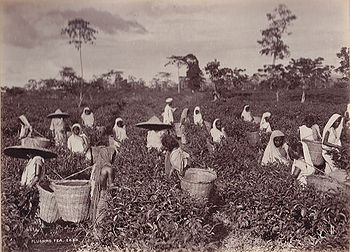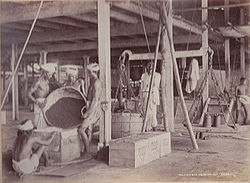Tea Plantation: Difference between revisions
No edit summary |
|||
| Line 67: | Line 67: | ||
*[http://www.archive.org/stream/bengalassambehar00playuoft#page/424/mode/2up ''Bengal and Assam, Behar and Orissa : their history, people, commerce and industrial resources''] by Somerset Playne , J W Bond 1917 at Archive.org lists four tea companies | *[http://www.archive.org/stream/bengalassambehar00playuoft#page/424/mode/2up ''Bengal and Assam, Behar and Orissa : their history, people, commerce and industrial resources''] by Somerset Playne , J W Bond 1917 at Archive.org lists four tea companies | ||
*[http://www.koi-hai.com/Default.aspx?id=477224#forgottenfrontierbygeoffreytyson ''Forgotten Frontier''] by Geoffrey Tyson, first published 1945, may be downloaded as a pdf from the Koi-Hai website. This book is about the escape of refugees from Burma in 1942 and the help provided by the tea planters of Assam in assisting the refugees from North Burma into India. | *Some sample pages from [http://www.koi-hai.com/Default.aspx?id=477224#forgottenfrontierbygeoffreytyson ''Forgotten Frontier''] by Geoffrey Tyson, first published 1945, may be downloaded as a pdf from the Koi-Hai website. This book may be viewed online on the [[Online books#Digital Library of India| Digital Library of India]] website.The book is about the escape of refugees from Burma in 1942 and the help provided by the tea planters of Assam in assisting the refugees from North Burma into India. | ||
==Recommended Reading== | ==Recommended Reading== | ||
Revision as of 10:47, 9 January 2014
Tea was originally a Chinese export first traded by the East India Company in 1685 from Canton (up river from Macao) and the trade was in 1750 a more valuable revenue stream than all of India. The trade was lost in 1833, and a year later native tea plants were found growing in Assam. Interest was reignited, the first export of tea from India was 12 tea chests in 1838. The Assam Tea Company took over the East India Company's tea plantations in 1839. By 1860, a million pounds (weight) of tea was being grown in:

- Assam
- Travancore
- Nilgiri Hills
- Kangra Valley
- Darjeeling
- Terai
- the Dooars
- Chittagong (now Bangladesh)
Fibis Resources
- Tea Planters Cachar 1865-1875 on the FIBIS database, over 200 names listed.
- FIBIS Journal Number 9, "Jokai Tea Estates" by Dick Barton. Includes a useful reading list.
- FIBIS Journal Number 24, "Life with Tea in India: The Diaries of Samuel Cleland Davidson" by Wendy Pratt and Peter Bleakley
- "Life with Tea and India: Diaries of Family Life in the Cachar Area". The first 10 minutes of a talk given by Wendy Pratt (FIBIS Member) and Peter Bleakley at the FIBIS Spring Lecture meeting 22 May 2010 is available to download or listen to on the podcast page. The full version is available for FIBIS members only in the FIBIS Social Network, previously known as the Members Area. Members can also access the accompanying visual presentation which displays impressive original material including photographs and equipment designs.
- Tea Images Images relating to tea planters and tea production comprising some of the original material mentioned above - examples of which are on this page.
Records

- From the end of the 19th century special sections covering tea plantations appear in Thacker's Indian Directories. FIBIS Fact File No 3 - Indian Directories by Richard Morgan states "The tea section lists within each area the names of the firms, their “tea gardens” (areas under cultivation), the trade mark or logo of the company as it was stamped on their tea chests , the postal address, acreage, proprietors, general managers and assistants, Indian agents and addresses, and London Agents and addresses”
An example is given of how a genealogical history can be obtained by using the annual directories in this context.
Some Thackers are available online, refer Directories online-Thacker's Indian Directory
- Guide to James Finlay & Co Managers and Assistants Letterbooks University of Glasgow. .Finlay Muir & Co as the company became known began to diversify into tea estate management around 1882 and by 1901 was managing extensive tea estates in India and Sri Lanka. These letterbooks contain a wealth of information about the men recruited in Britain to manage the Finlay tea estate business overseas
Volunteer Regiments
Volunteer Regiments involving tea planters include
- Northern Bengal Mounted Rifles with headquarters at Darjeeling
- Assam Valley Light Horse with headquarters at Dibrugarh
- Surma Valley Light Horse with headquarters at Silchar
- Punjab Light Horse had a detachment at Palampur in the Kangra Valley in 1898. It is not known whether this detachment continued past 1905, when many planters left the area following the 1905 Kangra earthquake.
Related articles
- Tea
- Schools-Dr Graham's Homes, Kalimpong, founded for the children of tea workers.
Historical books
- The British Library has the following book in its catalogue:
Taylor’s Maps of the following Tea Districts, Darjeeling, Terai, Jalpaiguri and Dooars, Darrang, Golaghat, Jorhat Nowgong, Sibsagar, Lakhimpur, Dibrugarh, Cachar, Sylhet, with complete Index to all Tea Gardens, published 1910
Historical books online
- Report No 23 : Report upon the present condition and future of tea cultivation in the north-west provinces and in the Punjab from Selections from the records of the Government of India (Home Department) 1857 Google Books
- Selections from the Public Correspondence of the Punjab Government Volume IV No 2: I Correspondence regarding Tea Plantations in the Punjab Provinces 1859 Google Books
- "Industrial Resources of British India" in The Quarterly Review contains a section on tea, Google Books, 1863
- Old times in Assam by T Kinney 1896 Archive.org A tea planter’s life in the early 1860’s. Reprints from columns in the Englishman and Indian Planters’ Gazette.
- A tea planter's life in Assam by George M Barker 1884. Archive.org. With seventy five illustrations by the author.
- The tea industry in India : a review of finance and labour, and a guide for capitalists and assistants by Samuel Baildon 1882 Archive.org
- The Tea planter's vade mecum : a volume of important articles, correspondence, and information of permanent interest and value regarding tea etc by the Editor of the Indian Tea Gazette 1885 Archive.org
- The Wynaad and the Planting Industry of Southern India by Francis Ford 1895 Archive.org
- Tea producing companies of India and Ceylon, showing the history and results of those capitalised in sterling by Gow, Wilson & Stanton, Tea and Tea Share Brokers 1897 Archive.org
- Indian Tea, its Culture & Manufacture by Claud Bald 1907. Archive.org (One of the books on the reading list in the Fibis Article mentioned above).
- The early history of the tea industry in north-east India by Harold Hart Mann 1918 Archive.org
- Bengal and Assam, Behar and Orissa : their history, people, commerce and industrial resources by Somerset Playne , J W Bond 1917 at Archive.org lists four tea companies
- Some sample pages from Forgotten Frontier by Geoffrey Tyson, first published 1945, may be downloaded as a pdf from the Koi-Hai website. This book may be viewed online on the Digital Library of India website.The book is about the escape of refugees from Burma in 1942 and the help provided by the tea planters of Assam in assisting the refugees from North Burma into India.
Recommended Reading
A Brief History of Tea by Roy Moxham (2009). For Review see Other occupations reading list.
External links
- Koi-Hai a site for those who lived and worked in North East India, particularly in the Tea industry. Includes articles, list of relevant books, photos, some grave inscriptions, tourism information
- Includes a link to a Directory (34 pages pdf which may be downloaded) published by the India Tea Association Calcutta 1930, consisting of a Complete Index to Tea Gardens in India (28 pages) and maps of the North Eastern tea areas: Sibsagar (computer page 30); Cachar p31; Dibrugarh (p32) Lakimpur (p33) and Sylhet (p34)
- Very interesting and detailed interviews of many aspects of the life and work of a tea planter. Travancore State, Calcutta, Darjeeling, N.W.F.P. Recorded by A.S. Robertson and his son, A.F. Robertson (1976 and 1979) from University of Cambridge - Centre of South Asian Studies. Listen to the interviews, or read the transcripts.
- Assam Where? Growing up in the tea growing district of Cachar during the late 1940s and the 1950s from Shangrilajournals.com. (There are links at the bottom of the page)
- Halycon [sic] days: a memoir of tea estate life by Duncan Allan The Statesman 25 April 2011 (Scroll down) (Another version (archived))
- Cultivating an Industry: A Survey of the lives of British Tea Planters in Assam 1860-1936 (html version) by A.H. Spielman 13 May 2009 Original link minds.wisconsin.edu
- Tea Planter in Bengal a posting from the rootsweb India mailing list archives giving advice and information on researching Tea Planters.
- Business records relating to tea companies in the Guildhall Library, London. It seems likely these companies are ones registered in the U.K.
- The Story of India Tea 1917 British Pathe film clip
- The Elephant Man is about the rescue of refugees fleeing Burma in 1942 by Gyles Mackrell, an Assam tea planter. He mounted an operation to save refugees who were trapped by flooded rivers at the border with India using the only means available to get them across - elephants. Includes YouTube film clip from the Centre of South Asian Studies, Cambridge. More about Gyles Mackrell’s story in this link theguardian.com (archive.org link)
- Assam Company Ltd Background to the Assam Tea Company and its Tea Plantations
- UPASI (The United Planters' Association of Southern India) is an apex body of planters of tea, coffee, rubber, pepper and cardamom in the Southern States of India viz. Tamil Nadu, Kerala and Karnataka in existence since 1893, located at Coonoor, Nilgiris. This India List post says they have records of all planters [for that area] and an extensive library going back nearly 100 years. Article A tea industry anniversary by S. Muthiah, Madras Miscellany March 24, 2013 The Hindu. The first tea auction at Coonoor was in 1863.
- When planters turned to their Directory of South India by K.V.S. Krishna Madras Musings Vol. XXI No. 5, June 16-30, 2011
- Article "Rubber soul" by Lesley Gillilan 28 October 2011 The Guardian mentions the rubber plantations in the foothills of the Western Ghats. (archive.org link)
- The Path to the Hills: History of the Plantations on Western Ghats. Tea Coffee and Rubber. html version, original pdf www.stayhomz.com
- "Total Tea Day:A Taste Of History. The museum at the Nullathani estate in Munnar November 9, 2012 thehindu.com
- History of Ceylon Tea includes many online publications including Ferguson’s Ceylon Directories from 1871 to 1930 (Broken range). For Ferguson’s Directories, this India List post advises "In the index on the left hand side look for an entry marked (usually) General Directory (towards the bottom) and then click on a page to see the contents".
- History of Ceylon Tea almarteas.com
- Blog with extracts from a booklet from 1935/36, a special edition of The Ringtonian, from the diary of Mr Samuel Smith during a journey to India and Ceylon. Rington’s, a tea and coffee merchant. Scroll to the bottom of the October 2012 Archives to commence. Includes photographs.